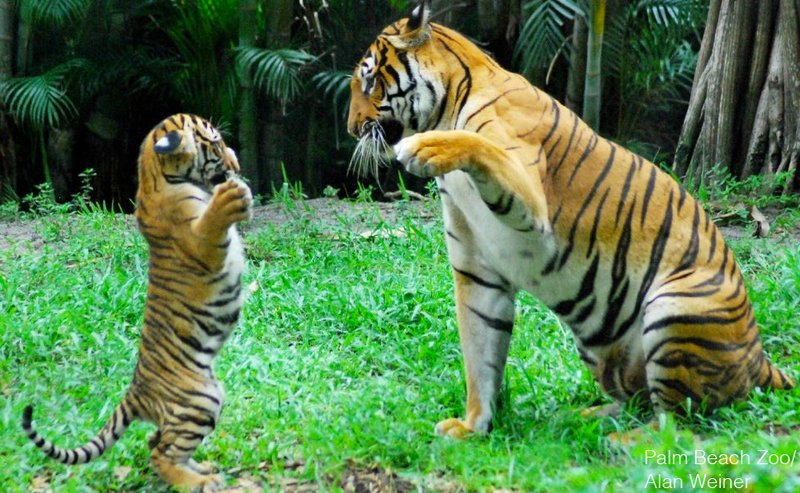
Malayan tigers are fascinating creatures, primarily found in the tropical forests of the Malay Peninsula. With their striking orange fur and distinctive black stripes, they are not just a sight to behold; they are also critically endangered, making their parenting strategies vital to the survival of the species. Let’s dive deeper into how these magnificent big cats raise their young, face challenges, and thrive in their natural habitat.
Mating and Gestation: Starting the Family
Before a Malayan tiger cub can be born, the journey begins with mating. Mating season typically peaks between November and April. During this time, females attract males through vocalizations and scent markings. Once a pair mates, the female tiger will enter a gestation period lasting about 93 to 112 days. Think of this as a time when the mother is preparing for the big event—getting her den ready and ensuring she has enough food to sustain herself and her growing cubs.
After this period, the mother typically gives birth to a litter of two to four cubs. It’s a bit like the start of a new chapter in her life. The dens are usually hidden in dense vegetation or rocky caves to keep the cubs safe from potential predators. Here’s the thing: while the mother is focused on her litter, she has to remain alert. It’s not just about giving birth; it’s about ensuring her little ones are safe and sound.
Cub Development: The First Few Months
Once those adorable cubs are born, their survival hinges on their mother. For the first few weeks, they’re completely dependent on her. Malayan tiger cubs are born blind and weigh about 1.5 pounds, which makes them incredibly vulnerable. During this time, the mother stays close, nursing them and keeping them warm. She’ll spend most of her days in the den, not straying too far for hunting due to the need for vigilance.
You might be wondering how the mother tiger manages. She uses her sharp instincts to know when to hunt for food. After about six weeks, the cubs start to open their eyes, and the mother slowly introduces them to the outside world. She’ll carry them to different spots to explore while keeping them close at paw’s length. This is a crucial time for their sensory development and early learning.
Learning to Hunt: Gaining Independence
By the time they are about two months old, the cubs begin to experience the thrill of playtime. But it’s not just fun and games. This playful behavior is essential for their survival skills. As they chase each other and pounce on leaves, they are practicing vital hunting techniques. It’s nature’s way of preparing them for the big world outside the den.
Around six months, the cubs start to join their mother on hunts. Watching her is like attending a masterclass on hunting. She teaches them how to stalk, ambush, and, ultimately, take down prey. The mother tiger’s role here is not just about feeding them but also about showing them how to fend for themselves. You can really see the blend of play and education—it’s a hands-on learning experience in the wild!
Maternal Care: Protection and Training
Malayan tiger mothers are incredibly protective. They won’t hesitate to confront threats, whether it’s another tiger or a larger predator, to keep their cubs safe. This instinct is critical, especially since young tigers can easily become targets themselves. Picture a lioness fiercely defending her cubs; it’s similar to a Malayan tiger’s approach.
During their upbringing, the mother teaches her cubs about territorial boundaries using vocal sounds and scent markings. These lessons are part of their training to become independent adults. By observing their mother, the cubs learn when to be stealthy and when to be cautious, shaping their personalities and instincts. Honestly, it’s a tough world out there, and having a capable guide makes all the difference.
Independence: Transitioning to Solitary Life
By the age of two years, Malayan tiger cubs are ready to leave their mother. It’s a bittersweet transition; the mother has spent so much time nurturing and protecting them, and now she must let them go to carve their own path. This stage is crucial because young tigers need to establish their own territories and hone their survival skills independently.
During this time, they might face challenges such as competition with other tigers and finding food. The lessons learned from their mother will come into play. Those hunting skills and territorial instincts that she painstakingly taught them are now essential for their success. This transition period is tough, but it’s a necessary part of their growth.
Conservation: The Future of Malayan Tigers
Unfortunately, Malayan tigers face numerous threats in their natural habitat, from habitat loss to poaching. The forest regions they rely on are shrinking, which means they have less space for raising their young and hunting. Conservation efforts are crucial to ensure that these magnificent animals can continue their legacy of nurturing future generations.
Organizations are working hard to protect their habitats and educate local communities about the importance of preserving these tigers. This is not just about saving a species; it’s about maintaining the whole ecosystem. If we lose the Malayan tiger, we risk upsetting the balance of their entire habitat.
Raising young in the wild is a beautiful yet challenging journey for Malayan tigers. From the careful selection of a den to teaching their cubs about hunting and territory, these mothers demonstrate resilience and dedication. Just like in human families, the lessons learned during childhood shape who these cubs will become as they step into the world.
You might see a Malayan tiger as just another big cat, but their life is a vivid tapestry of love, survival, and growth. Each cub raised successfully contributes to the future of their species, reminding us of the importance of the natural world. The next time you hear about Malayan tigers, remember their incredible parenting skills and what’s at stake for their young. Every bit of effort counts in the push to ensure these magnificent creatures thrive for generations to come.

